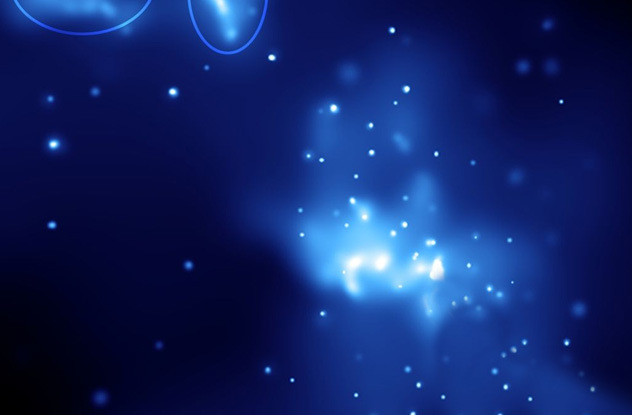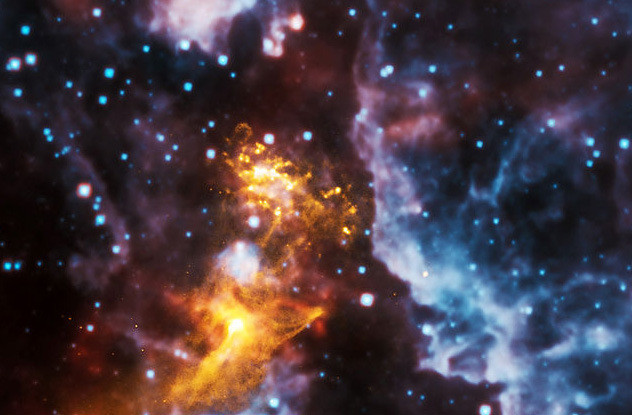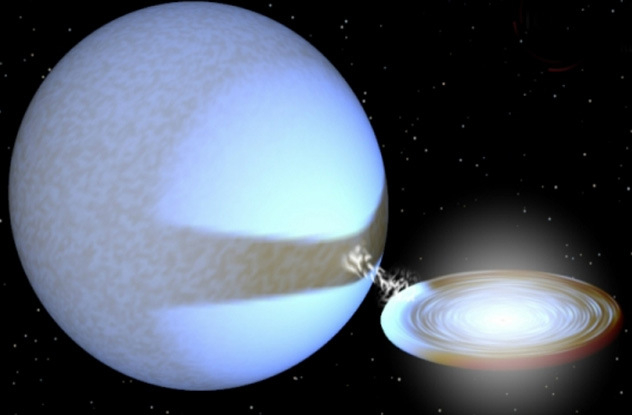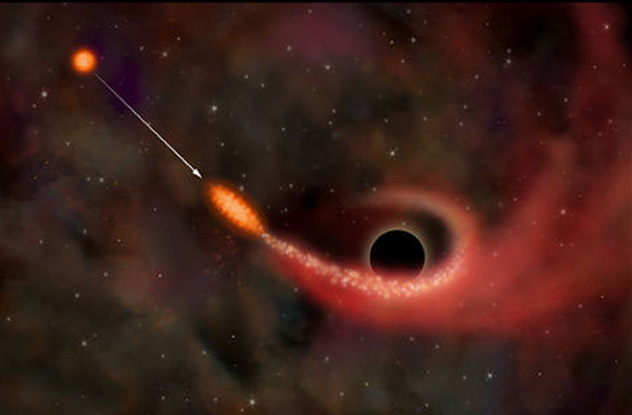10 interesting facts about black holes in the universe (Part 1)
A black hole (black hole or black hole) is a spacetime region in the universe whose gravity is so great that everything including light cannot escape. So even though we have known black holes for a long time, what we know about them is only scientific theory. Black holes have a lot of mysteries that we don't know yet, can't explain.
1. Human ancestors may have seen a giant black hole in the center of the Milky Way
Because black holes have a great gravitational force that makes light impossible to escape, they cannot glow like stars in the sky and humans cannot observe black holes normally.
 10 interesting facts about black holes in the universe (Part 1) Picture 1
10 interesting facts about black holes in the universe (Part 1) Picture 1
However, by the time the black hole was most active, a large amount of surrounding matter was sucked in to form a heated geology by colliding at the black hole. When a certain threshold is reached, high-energy matter particles can be ejected in a direction perpendicular to the black hole. A light explosion was created.
This light explosion can last for thousands of years. Looking from Earth, it is like a big star glowing in the night sky.
According to scientists, two million years ago this phenomenon happened to the supermassive black hole in the center of the Milky Way and emitted brilliant light. At that time, people were just beginning to evolve and stand on two feet, but it was very likely that our ancestors had witnessed this rare special event in the sky of Earth.
Currently, Sagittarius A, the supermassive black hole in the center of our Milky Way, is stable, so perhaps humans will not have a chance to see the light show of a supermassive black hole. like that.
2. Not only will black holes swallow everything
 10 interesting facts about black holes in the universe (Part 1) Picture 2
10 interesting facts about black holes in the universe (Part 1) Picture 2
When a star is swallowed by a black hole, gas and dust from the star will be swept into the black hole at high speed, causing it to heat up, emitting light. Those are the X-ray beams that we observe.
Astronomers were surprised to discover a high-energy X-ray beam when observing the galaxy M82. This phenomenon is quite similar to the activity of a black hole when swallowing a star but it must be so. It is a neutron star, the rest of a dying star but not large enough to form a black hole. It has the same characteristics as a black hole, sucking in dust and gas from a close distance but not as powerful as a black hole. After completing this process, the neutron star will cool down and stop working.
3. Ultra-small black pit, greedy monsters
 10 interesting facts about black holes in the universe (Part 1) Picture 3
10 interesting facts about black holes in the universe (Part 1) Picture 3
Mass is the most important thing in the cosmic world, not size.
Scientists have discovered the P13 black hole, which is about one-fifth the size of the Sun but has a million times the mass.
When discovered, the P13 black hole is swallowing a giant star that is much larger than it is many times. According to astronomers' calculations, every minute P13 can consume matter by the mass of about 100 billion sausages. With this ability, P13 will eat the star near it in about 1 million years, a relatively short time in the universe.
4. The number of supermassive black holes
 10 interesting facts about black holes in the universe (Part 1) Picture 4
10 interesting facts about black holes in the universe (Part 1) Picture 4
Black holes vary in size, from as small as a planet to as large as the solar system, but there are also very rare giant black holes called ultramassive.
As we know, at each center of a galaxy there exist super-giant black holes. Besides, scientists also discovered more than 100 small dwarf galaxies also have black holes at the center of their universe.
Compared to the Milky Way galaxy there are about 200-400 billion stars, dwarf galaxies are much smaller in size and they have only a few billion stars. But the size of the black hole in their center is not small.
At M60-UCD1, a dwarf galaxy exists with a black hole that is 2 million times the mass of the Sun.
Since then, scientists believe that, when large galaxies collide, they are torn apart to create dwarf galaxies. And it is very likely that the number of black holes in the universe will correspond to the number of dwarf galaxies. However, they cannot explain the existence of giant black holes at the center of these dwarf galaxies.
5. How a black hole grows
 10 interesting facts about black holes in the universe (Part 1) Picture 5
10 interesting facts about black holes in the universe (Part 1) Picture 5
As we know, black holes suck gas, dust in the universe and stars near it to form and grow. This process creates an accretion disk, providing material to the black hole. But in this process, there is also an outward reaction that makes the absorption of matter from the accretion disk happen very slowly, thus reducing the growth rate of a black hole.
According to scientists, in the first time, black holes only need to take 10 million years to increase the mass from 10 times to 10,000 times the solar mass. If only absorbing material from accretion disk can not reach such a rapid growth rate. Therefore, they hypothesized that black holes moved to hunt.
Scientists believe that a newly formed young black hole has its own orbit and works very hard. Initially, they move in space and quickly absorb material from new stars. They will then slowly slow down and, according to calculations, the limit of a black hole is 1 billion times the mass of the Sun. Currently, scientists have discovered that the supermassive black hole at the center of the Milky Way is only about 4 million solar masses.
- 10 interesting facts about black holes in the universe (Part 2)
- Discover the terrible war between two giant black holes in the universe
- Successfully creating cosmic black holes, demonstrating Hawking radiation exists
You should read it
- Discover the most bizarre black holes in the mysterious space universe
- 10 interesting facts about black holes in the universe (Part 2)
- The discovery of a giant black hole, 70 times the mass of the Sun in the Milky Way, challenges every theory
- black hole, white hole, deep hole
- Detecting monstrous black holes, 20 billion times larger than the sun and growing 'fast'
- Successfully creating cosmic black holes, demonstrating Hawking radiation exists
- A new discovery about the strange interaction between cosmic black holes and light
- Our galaxy contains countless invisible black holes?
- Detecting an active supermassive black hole at an unprecedented distance
- Find out how to weigh black holes based on galaxy spiral arms
- Hubble begins its hunt for hard-to-identify medium-sized black holes
- If people fall into a black hole, what horrors will await them?
May be interested

10 interesting facts about black holes in the universe (Part 2)

Future prospects when people own the solar system

The 7 largest objects people ever launched into space

Can the probe of Solar Probe Plus reach near the Sun?

Telescope giant FAST in China participated in the 'international hunt' to seek extraterrestrial life

Photos of the 9th planet in our solar system






 10 interesting facts about black holes in the universe (Part 2)
10 interesting facts about black holes in the universe (Part 2) Discover the most bizarre black holes in the mysterious space universe
Discover the most bizarre black holes in the mysterious space universe A new discovery about the strange interaction between cosmic black holes and light
A new discovery about the strange interaction between cosmic black holes and light Successfully creating cosmic black holes, demonstrating Hawking radiation exists
Successfully creating cosmic black holes, demonstrating Hawking radiation exists 40 interesting facts you didn't know about the Sun.
40 interesting facts you didn't know about the Sun. Detecting monstrous black holes, 20 billion times larger than the sun and growing 'fast'
Detecting monstrous black holes, 20 billion times larger than the sun and growing 'fast'